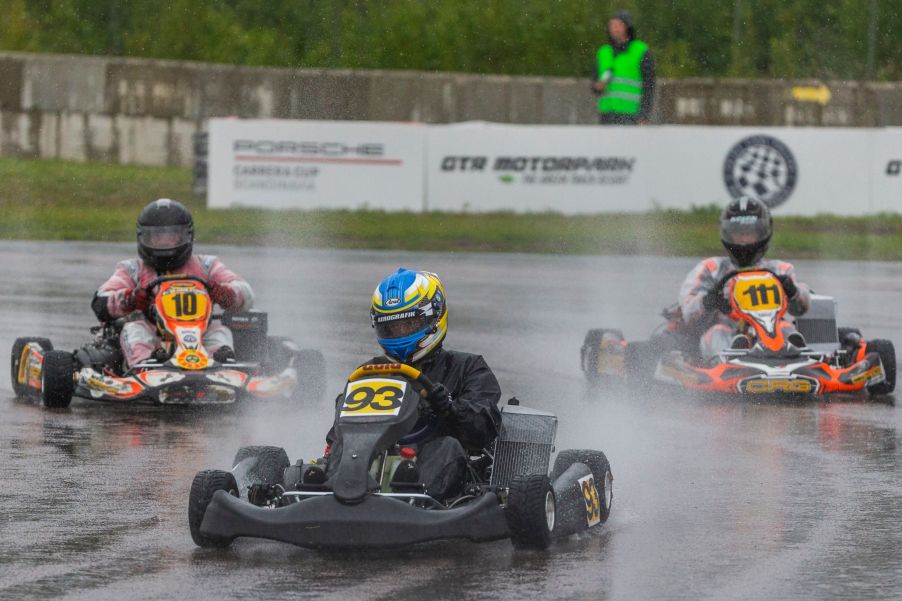
Want to Go Karting? It’s Easier Than You Might Think
Attending a race is certainly fun, but racing participation isn’t limited to being a spectator. With the right prep-work, budget, and attitude, anyone can take part. True, you might not ever be a Formula 1 driver. But you can compete in the same kind of motorsport that many F1 drivers started in: karting.
What makes kart racing different than go-karting?

You might have already experienced a version of karting in the form of go-karts. But while they’re technically part of the same family, they’re to race karts what cars are to, well, race cars.
A ‘true’ race kart can get up to triple-digit speeds and go from 0-60 mph in under four seconds, Autoblog notes. Racers often experience 3.0g as they come around a corner. As such, this isn’t exactly an amusement park attraction.
Today, kart racing is organized into club, regional, and national levels. And the racers and karts are further split into different classes based on several factors, MotorTrend explains. Engine size and type (two-stroke vs. four-stroke), engine manufacturer, driver and kart weight, and skill level are the main ones. Furthermore, sprint racing doesn’t involve shifting, while shifter karts, as their name implies, have multi-speed gearboxes.

Despite this seeming complexity, race karts are rather simple—almost deceptively so, Road & Track explains. There’s a steel-tube frame, a seat, a chain-driven engine, some pedals, a steering wheel, and maybe a shifter. Apart from the body panels, wheels, and tires, that’s it. There isn’t even any ‘real’ suspension; instead, the frame is the suspension. And its various tubes have to be tuned to make the kart handle.
That last part explains why many skilled racing drivers, from Lewis Hamilton to Jeff Gordon, started karting as kids. And it’s why, even if you aren’t a kid, it’s a racing activity worth considering.
Kart racing isn’t necessarily dangerous and isn’t only for kids
To be sure, karting has its inherent risks, just like any motorsport. But participants aren’t unprotected.
Whether or adult or child, racers wear helmets, racing suits, gloves, sturdy shoes, as well as neck and rib protection, Sima Racing notes. Although the seat doesn’t have a harness, it’s snug enough that it’s unnecessary, R&T explains. And while racing karts can reach high speeds, racers don’t start with the most extreme ones. Like with autocross racing, you build up to the highest echelons.
Although starting as a kid is practically a requirement for going pro, adults benefit from participating, too. Because racing karts are so simple, they’re easy to work on and use to develop wrenching skills. But that simplicity also means small tweaks can lead to big changes on the track, R&T explains. Change one tube, or reposition the seat slightly, and the handling radically changes.
That leads into one of kart racing’s main lessons: how to drive properly. Driving a racing kart is a full-body experience, literally, R&T muses. You have to manage weight transfer and grip not just by turning the wheel but by moving your body. Sometimes, going around a corner means twisting the wheel and shoving your weight to one side. It’s all about understanding where the grip is and how to exploit it.
All this explains why so many high-tier racers got their start in karting. As racer Memo Gidley explained to R&T, “Once you’re successful in karts, you can race anything.”
How much does it cost to get involved?
Karting has one more positive aspect, though, and that’s cost. Compared to many other forms of motorsport, kart racing is fairly cheap to get into. However, it’s not exactly inexpensive, either.
Before you go shopping, look to see what kind of racing class you’d like to participate in. Some classes have a ‘spec’ build to make the field as level as possible. This also simplifies the process of buying and/or building the kart, which is usually the most expensive investment.
New racing karts can be bought as rollers, sans engines, or in turn-key condition. The exact cost varies based on the racing class, but $5000 is a good rough estimate. But if you’re just starting, buying a used one is fine, as long as it’s no more than five years old, Sima Racing notes. That’s because the forces generated during racing physically change the frame tubes’ material properties. After a few years, the tubes have to be replaced because they’ve lost their ‘snap,’ R&T explains.
Speaking of replacing parts, spare parts and tools are something else to budget for. So is proper safety gear, fuel, and tires, along with transportation for everything and everyone. Then there are race registration and membership fees. All told, the average racer spends about $10,000-$15,000 per year, R&T says.
If you’re not sold on karting or spending that much money on an annual basis, try a lesson at a local school. For a few hundred dollars, you can experience racing speeds without going all in. Though you might walk away wanting more than just a taste.
Follow more updates from MotorBiscuit on our Facebook page.


